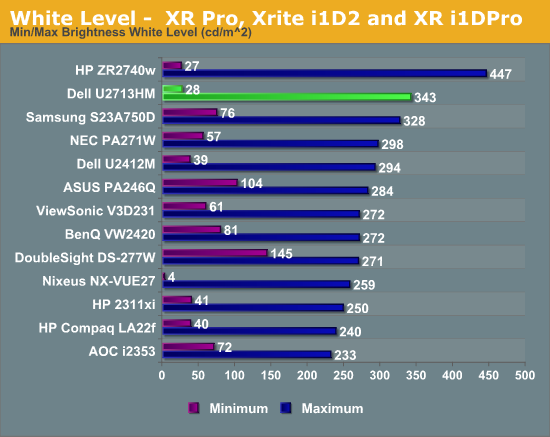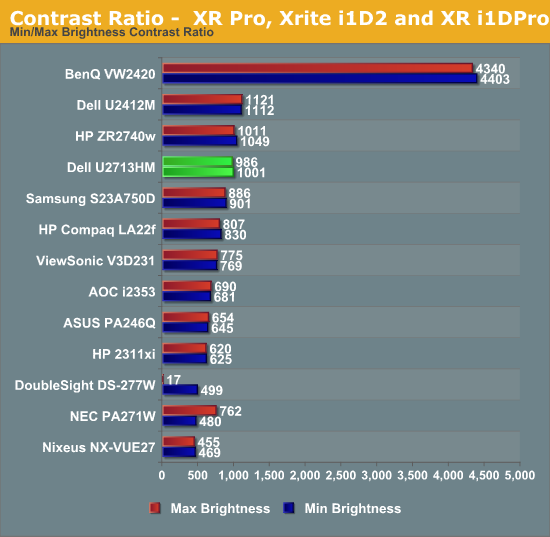Dell U2713HM - Unbeatable performance out of the box
by Chris Heinonen on October 4, 2012 12:00 AM ESTDell U2713HM Brightness and Contrast
Last review I changed how I measured brightness and contrast to use a 5x5 ANSI grid instead of solid black and white screens in order to provide more accurate data. I wasn’t sure how this would impact screens, making comparisons between models harder. Measuring the center square of the 5x5 ANSI grid, the maximum brightness I could obtain from the U2713HM is 343 nits, which is very close to the 350 nits listed in the specs. With the backlight set to minimum that drops down to 28 nits, giving you a wide range of brightness levels to choose from.

Black levels are where I expected the most impact with the new testing, since an ANSI grid prevents LED systems from going to full black. Preventing these systems from kicking in gives a much better real-world idea of the contrast ratio for a monitor. The U2713HM does a good job with the new measurements, as seen in the chart below.

Figuring out the contrast ratio from the avove data is simple. There’s some slight rounding, but otherwise we see contrast ratios very close to 1000:1 for the display at both maximum and minimum brightness. This stacks up very well compared to all the other 27” displays that have been tested, and using a more stringent standard. The contrast numbers from the Dell are very good overall,

With a good foundation of brightness and contrast levels, it’s time to see how the Dell performs with color.










101 Comments
View All Comments
ricardoduarte - Thursday, October 4, 2012 - link
I completly disagree with your coment, we had expensive Dell monitors at my previous workplace, and performance wise i could not see any distinct visual increment in performance from dell screens at our work from any other screens. (Maybe they weren't that good). But my point is that Dell screens when they are better they are never much better (if we consider day-to-day usage not with synthetic benchmarks) which to me does not justify the premium that these screens cost. I have found to be honest Dell screens always too expensive, for what they offer since their performance is just marginally better to the koreans screens you mention, but with a premium price when compared to these.With respect to the korean comments, i still have working 17" LG on a spare PC, screen thats is almost 7years old. I have also a 21" samsung that is 3 years old which has never gave a problem or even dead pixels.
I also have 2 19" Asus (which are not korean) that i used for 6years non stop without ever gaving a problem or even dead pixels which are now stored since i got two phillips screens 23".
rituraj - Thursday, October 4, 2012 - link
Well, I think by "Korean" Deo didn't mean Samsung or LG, but those brands that you have never or hardly heard of. Sam & LG are not that cheap (and therefore quite reliable too)Penti - Thursday, October 4, 2012 - link
Too expensive? Dell monitors are about the most reasonable priced among monitors, and it's competitors aren't normally cheaper. My Samsung has a Taiwanese panel btw so I'm not sure why your on about brands. Brands it self doesn't mean quality. Most has used awful components like faulty Taiwanese caps that give up in a couple of years (I have changed some of mines). The OP was talking about no-name Korean brands like Yamakasi, Achieva Shimian etc. They could be seen equal to say a Meizu M9 Android phone or Ainol tablets and even lesser know stuff i.e. is produced by lesser skilled teams with no markups/margins to speak of. With no manufacturing capabilities of their own in most cases. In most cases with some drawbacks. With screens there is also other grades/classifications too. Backlight and the panel assembly might not be as good either. Philips doesn't produce monitors btw it's the Hong-Kong based TPV that does so since about 2005, which now also holds the stake in designing/development of, and most of the assembly of (which are quite popular in Europe btw) Philips television sets.At least here in Sweden Dell's aren't more expensive and rather cheap compared to the same class HP, Asus, Acer, NEC, LG, BenQ, Samsung, Eizo etc. Any Asus that uses a IPS-panel will have a Korean panel in it for that matter. You don't have much to choose from here except LG Display and Samsung Display when it comes to [IPS-based] desktop monitors, which also happens to be the biggest of the manufacturers. Those that orders the panels as components and puts together their own stuff like the no-names though can half the price of these monitors. But they use much worse electronics and IC's driving the monitors and is much less engineered. They simply can't spend 50-100 dollar on those parts.
You see instantly the difference when your on a none-TN monitor compared to TN monitors with poor viewing angles and you should definitely be capable to tell the difference in an office environment, as they was out when viewed from an angle and the colors shift terribly just sitting straight in front of it, unless you used cheap monitors. Cheap monitors doesn't in many cases even have proper adjustable stands for that matter. It's not like you need the whole AdobeRGB color space when your in an Office document either. But it also is the whole of the sums that counts decent adjustable stands, panel quality and type, inputs and input lag, viewing angles and resolution. Backlight also impacts on power consumption if that is important. You don't get all of that in cheaper alternatives if you don't want to make some fairly large compromises, you won't get the same amount of control over the monitor and it's only recently you have been able to get high-res panels in those no-name monitors. If that is not what you want then why wouldn't you just buy some lower res 1920x1080 MVA or e-IPS monitor? They are also easier to drive from notebooks. Plus cheaper than Ebay imports. But you might need to accept dithering there if your not careful.
mcnabney - Thursday, October 4, 2012 - link
They will have 4K monitors eleven years ago.Have you already forgotten the IBM T220/T221 and its 204 ppi glory?
Sabresiberian - Thursday, October 4, 2012 - link
I disagree here; the price is far too high in light of the competition. Dell makes nice monitors (I have a U2711 that I'm quite fond of), but there is no way I'd buy this over the HP ZR2740w. It is very clear to me that Americans and Europeans are paying a higher price just becasue they have more money in their collective pockets, and we shouldn't stand for it.Perhaps this monitor will see deep discounts from other retailers that bring it within range of the HP, but right now I'd go ahead and buy another U2711 from Newegg for $850 instead of this one. These monitors should sell for around $500-550, not $650-800.
;)
atticus14 - Friday, October 5, 2012 - link
Dell likes to inflate MSRP and do some pretty hefty sales. They constantly have very competitive deals and I dont know if its still the same but if you buy their premium monitors (which include their much cheaper eIPS monitors) they come with a solid warranty - i havent been in the market for years but it used to be a 3 year 0 dead pixel policy.You just got to look for deals.
wickman - Thursday, October 4, 2012 - link
The first high end LCD I bought was a Dell 2407, back in 06 or 07 and it still runs today problem free managing my servers. I don't have any other LCDs of that age still running, though I'm sure somebody does but that may say something to their quality.But my main reason for buying Dell then, as it is today is their advance replacement warranty service. I use a U2711 on my main system today and I had some issues with the card reader flaking out on me (would stop reading my SD card half way through transferring data), then a week later it up and died so I went on the chat service and explained the issue. They asked for some information from me about the monitor (serial, model, etc) and the next day the replacement monitor was at my door. I popped the new monitor on my wall bracket, dropped the defective one in the same box, applied the pre-paid sticker and instead of calling Fedex to pick it up (which I could have) I just dropped it off myself. Job done, no RMA numbers, no emails, no phone calls, just 10 minutes of web chat and no real down time.
So that type of service is something that really should be noted right up there with features like USB 3.0, more inputs, better calibration, etc. Quality service and warranty can mean less downtime should the unthinkable occur. Included 3 years, expandable to 5 year and you can even choose to cover accidental damage for additional fee. Honestly that is probably a rip off, I'll have to see what the fine print says on that one...
Chillin1248 - Thursday, October 4, 2012 - link
Could the input lag results be skewed due to the fact that you were using Startech adapter or because the way your Macbook was behaving?cheinonen - Thursday, October 4, 2012 - link
Lag results are done on a PC, straight from the video card, as SMTT is a Windows program. I'll make that more clear in the text.silverblue - Thursday, October 4, 2012 - link
Excuse my ignorance, but if you don't have a CRT that can work at 1440p, how about dropping it to 720p, or would that be an invalid testing scenario?